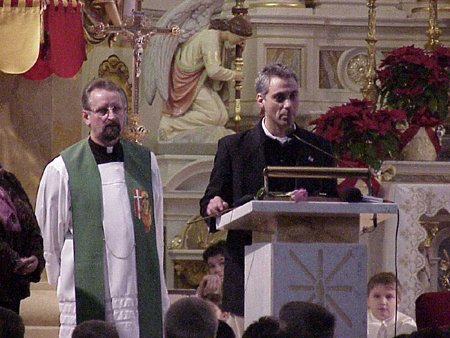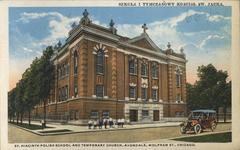
Basilica of St. Hyacinth Chicago: Visiting Hours, Tickets, and Historical Significance
Date: 14/06/2025
Introduction
The Basilica of St. Hyacinth in Chicago’s Avondale neighborhood is a stunning architectural landmark and a vibrant center of Polish-American culture, faith, and community. Since its founding in 1894, the basilica has served as a spiritual anchor for generations of Polish immigrants and continues to welcome visitors from around the world. This comprehensive guide provides essential information on the basilica’s history, architectural highlights, visiting hours, ticketing, accessibility, and nearby attractions, ensuring a meaningful and well-prepared visit.
Authoritative sources for this guide include the official basilica website, masstime.us, Chicago Tribune, Chicago Architecture Center, and the Polish Museum of America.
Table of Contents
- Origins and Founding
- Architectural Significance
- Interior Art and Devotional Highlights
- Visitor Information: Hours, Tickets, and Accessibility
- Community Role and Cultural Importance
- Special Events and Nearby Attractions
- Preservation and Restoration
- Frequently Asked Questions (FAQ)
- Plan Your Visit
- References
Origins and Founding
St. Hyacinth Basilica was established in 1894 by Polish immigrants seeking both spiritual guidance and a community hub in Chicago’s northwest. The initial wooden church was quickly replaced by the current monumental structure, constructed between 1917 and 1921. Dedicated to St. Hyacinth, a prominent Polish Dominican saint, the basilica became a beacon for Polish Catholics and an enduring symbol of their heritage in the United States (masstime.us).
Architectural Significance
Design and Style
The basilica is a prime example of the “Polish Cathedral” style—a unique blend of Renaissance Revival and Baroque influences. Designed by the renowned firm Worthmann & Steinbach, the facade features twin towers, intricate stonework, and classical ornamentation. The massive central dome, copper-clad and rising 80 feet high, is visible throughout the neighborhood and symbolizes spiritual aspiration.
Materials and Craftsmanship
Indiana limestone forms the basilica’s imposing exterior, while the interior dazzles with imported Italian marble, hand-carved woodwork, and stained glass windows created by Bavarian and Polish artisans. Murals by John A. Mallin and detailed side altars further reflect the community’s artistic devotion (Chicago Architecture Center).
Interior Art and Devotional Highlights
The nave accommodates over 1,500 worshippers beneath soaring barrel vaults and Corinthian columns. Stained glass windows depict biblical scenes and Polish saints, filling the space with vibrant color and narrative.
The sanctuary’s Italian marble altar sits beneath an ornate baldachin, with a Renaissance-style fresco of the Assumption of the Virgin Mary in the apse. The basilica also houses an extensive collection of relics, including those of St. Hyacinth, St. John Paul II, and St. Padre Pio, displayed year-round in the vestibule and brought forth on special feast days (The Catholic Travel Guide).
Visitor Information: Hours, Tickets, and Accessibility
- Address: 3636 West Wolfram Street, Chicago, IL
- Visiting Hours: Generally Monday–Saturday, 8:00 AM–6:00 PM; Sunday, 7:00 AM–7:00 PM. Hours may vary during special liturgies or holidays—check the official website for updates.
- Tickets and Admission: Admission is free. Donations are appreciated to support preservation.
- Guided Tours: Self-guided tours are encouraged with informational brochures available at the entrance. Group tours can be arranged in advance through the basilica office.
- Accessibility: Wheelchair accessible entrances and restrooms are provided.
- Public Transit: Accessible via the CTA Belmont Blue Line and several bus routes. Limited street parking is available.
Community Role and Cultural Importance
St. Hyacinth Basilica is more than an architectural gem—it is a living center for Chicago’s Polish-American community. The church offers daily Masses in English and Polish, celebrates major feasts such as Corpus Christi and St. Hyacinth’s Day, and hosts cultural events including the blessing of Easter baskets (Święconka) and Christmas Midnight Mass (Polish Museum of America). St. Hyacinth Academy, the associated parochial school, emphasizes Polish language and culture.
The basilica is also a pilgrimage site, especially during Jubilee Years, and has welcomed dignitaries such as Lech Wałęsa and Pope John Paul II (before his papacy) (Chicago Tribune).
Special Events and Nearby Attractions
- Feast of St. Hyacinth (August 17): Special liturgies and processions.
- All Saints’ Day: Public display of relics.
- Concerts and Lectures: Regularly held in the basilica’s concert-quality acoustics.
- Neighborhood Attractions: Explore the Polish Museum of America, other “Polish Cathedral” churches like St. Mary of the Angels and St. Stanislaus Kostka, and enjoy local Polish restaurants and shops (Chicagoland Muse and Views).
Preservation and Restoration
Ongoing restoration projects have preserved the basilica’s limestone facade, cleaned and repaired stained glass windows, and restored historic murals. These efforts ensure the site remains a vibrant part of Chicago’s religious and cultural landscape for future generations (Landmarks Illinois).
Frequently Asked Questions (FAQ)
Q: What are the basilica’s visiting hours?
A: Typically Monday–Saturday, 8:00 AM–6:00 PM; Sunday, 7:00 AM–7:00 PM. Check the official website for updates.
Q: Is there an entrance fee?
A: No, admission is free; donations are welcome.
Q: Are guided tours available?
A: Self-guided tours are encouraged; group tours can be scheduled in advance.
Q: Is the basilica wheelchair accessible?
A: Yes, with ramps and accessible restrooms.
Q: Can I take photos inside?
A: Non-flash photography is allowed outside of services; please be respectful.
Q: What nearby attractions are recommended?
A: The Polish Museum of America, St. Stanislaus Kostka Church, and local Polish shops and restaurants.
Plan Your Visit
For the most current information on visiting hours, guided tours, and special events, consult the official Basilica of St. Hyacinth website. Enhance your experience with the Audiala app for guided audio tours and insider tips. Extend your Chicago itinerary with visits to other Polish heritage sites and cultural landmarks.
Visuals
Summary and Final Tips
The Basilica of St. Hyacinth is a unique fusion of faith, history, and artistry—a testament to the enduring legacy of Chicago’s Polish-American community. With its awe-inspiring architecture, beautiful art, and vibrant liturgical life, the basilica is a must-visit for anyone interested in Chicago’s cultural and religious heritage. Admission is free, and the basilica is accessible to all. For an optimal experience, check the latest schedules, consider attending a Mass or special event, and explore the surrounding neighborhood’s cultural offerings.
References
- Basilica of St. Hyacinth Chicago: Visiting Hours, Tickets & Historical Guide (masstime.us)
- Visiting the Basilica of St. Hyacinth in Chicago: Hours, Tickets, and Architectural Highlights (official basilica website)
- Basilica of St. Hyacinth: A Cultural and Historical Gem in Chicago’s Avondale Neighborhood (Polish Museum of America), (Archdiocese of Chicago)
- Community’s Devotion Helps St. Hyacinth Become Basilica (Chicago Tribune)
- Chicago Architecture Center (Chicago Architecture Center)
- Additional sources: The Catholic Travel Guide, Chicagoland Muse and Views, Landmarks Illinois, Wikipedia





























































































































































